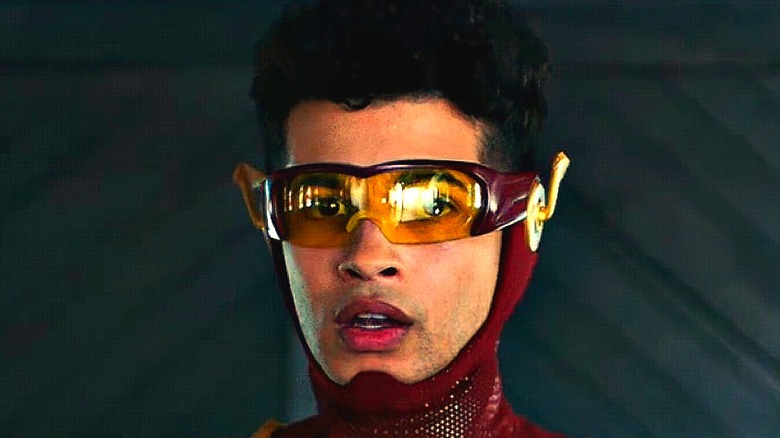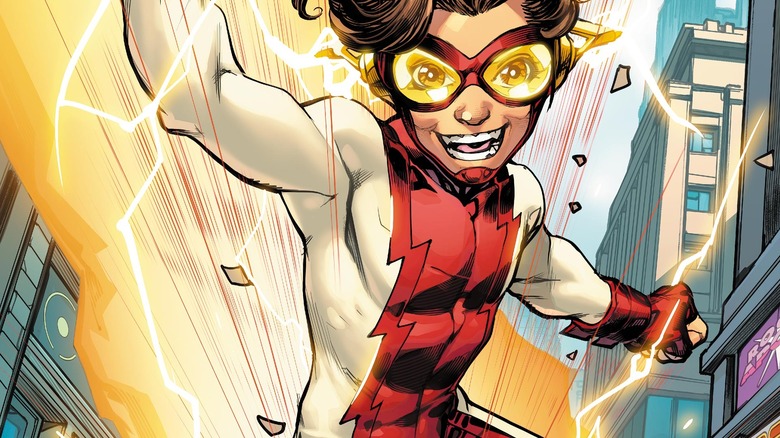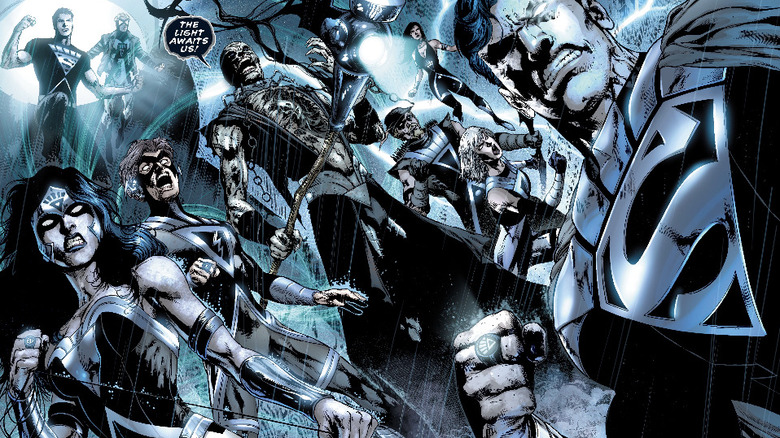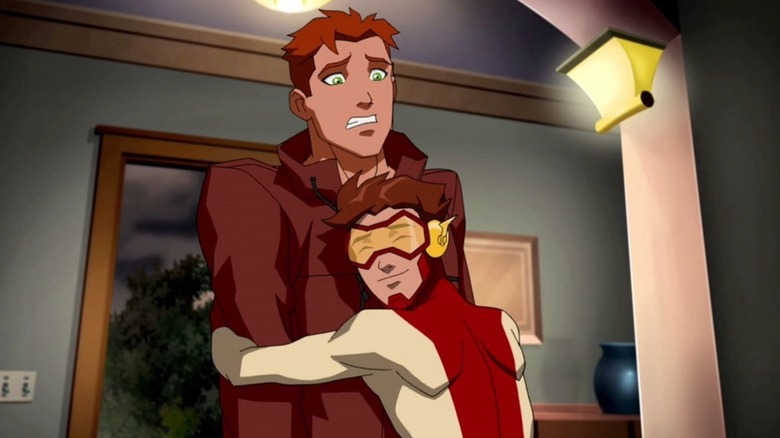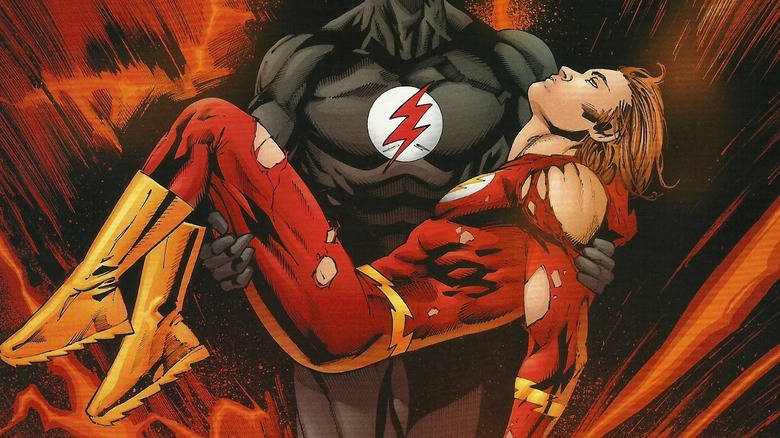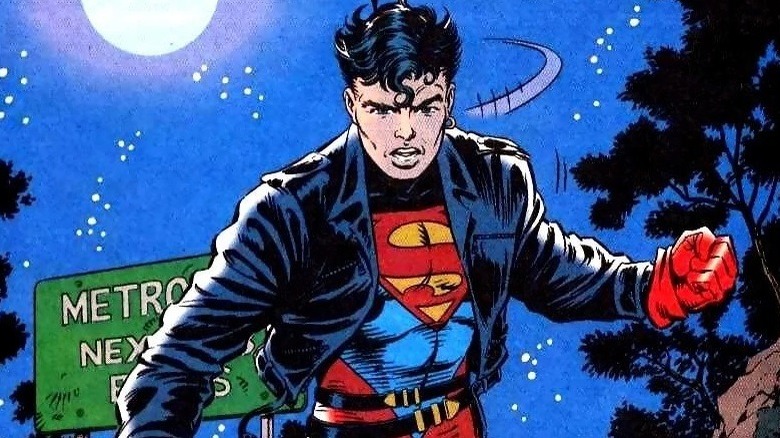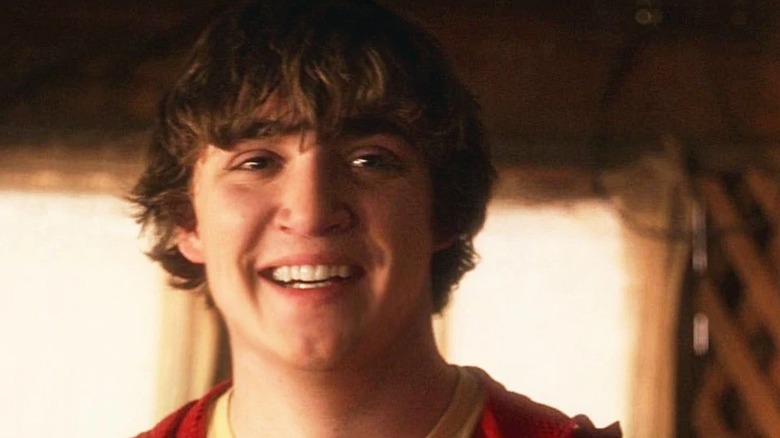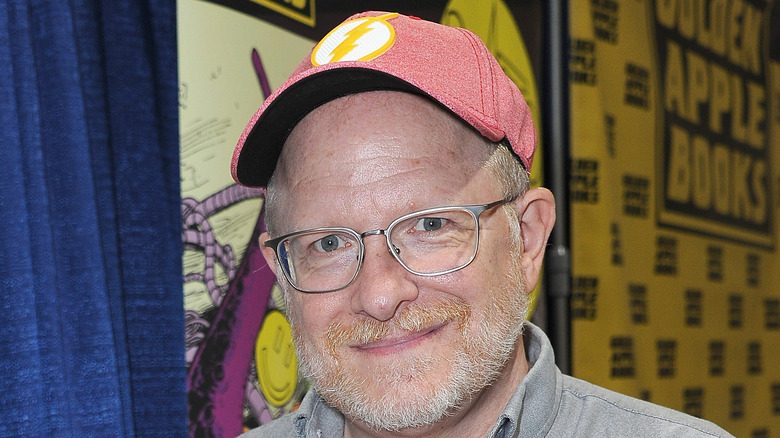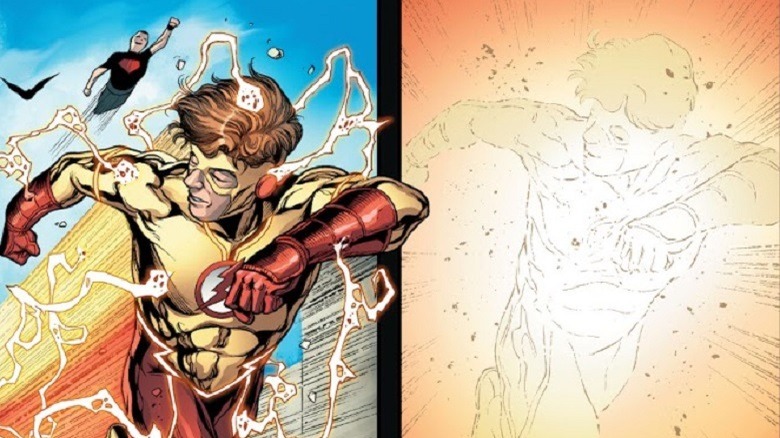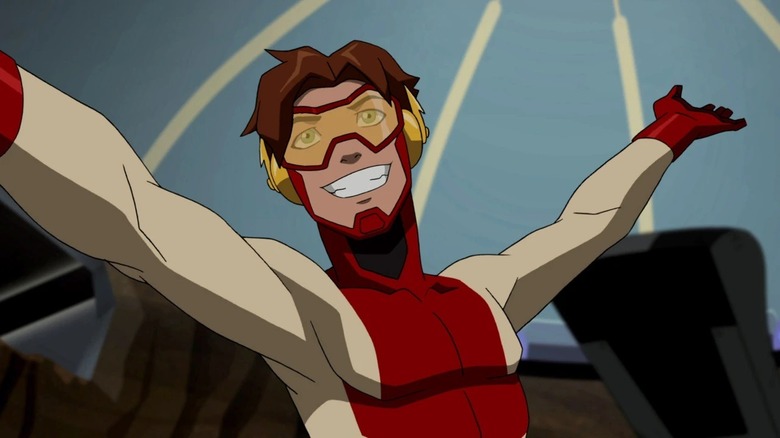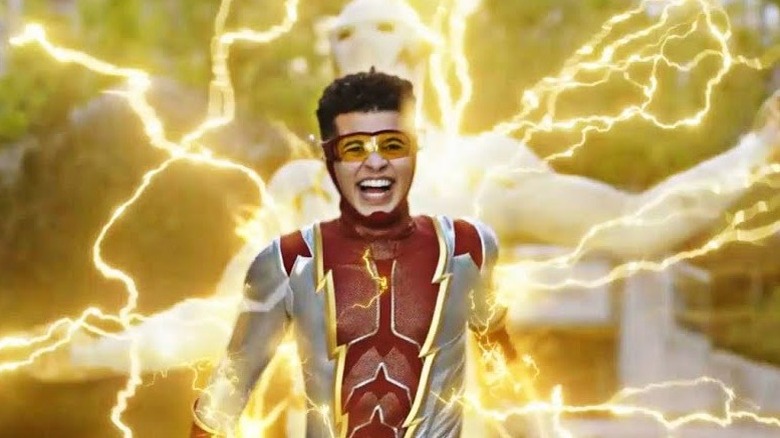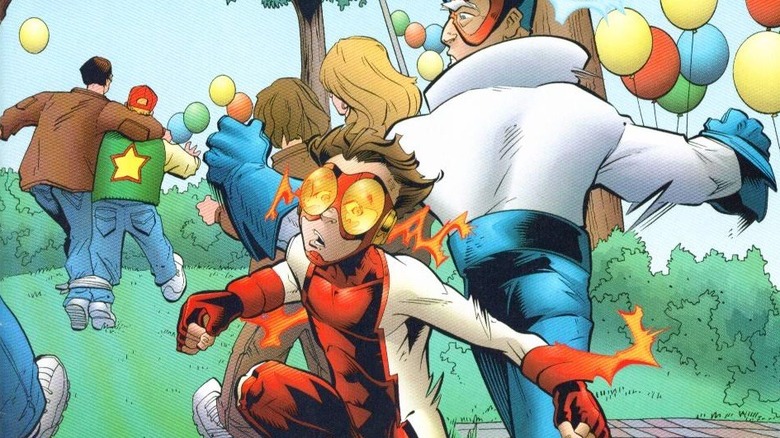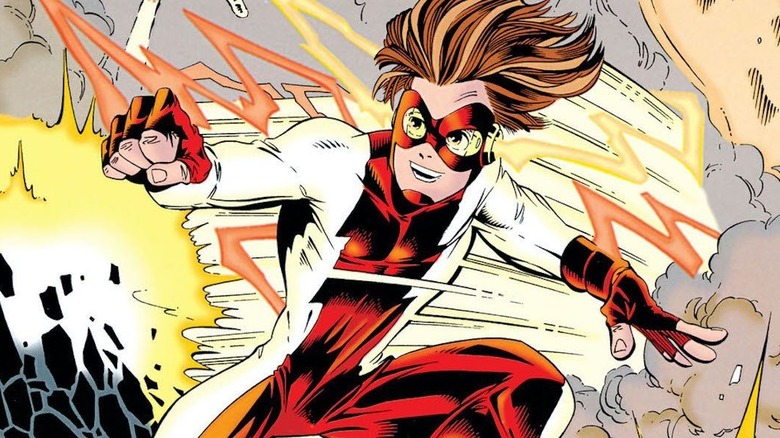The Untold Truth Of DC's Bart Allen
So a speedster runs into Central City. That isn't the beginning of a joke; it's something that often happens as Central City appears to be a lightning rod for people connected to the Speed Force. One of the most popular speed demons not named Barry Allen or Wally West is Bart Allen, aka Impulse or Kid Flash. Since debuting in 1994, per DC Comics, Bart has always brought something new and fresh to Team Flash as his fast-talking and excitable nature sets him apart from his fleet-footed teammates.
However, Bart's race around the DC Universe has been far from smooth or easygoing. His history has consisted of many sharp turns and dangerous corners that he has had to navigate to stay on course and maintain his originality. Some of these obstacles were products of their time, while others grew out of editorial interference. From the creators fighting for him to not become just another Flash to his eventual turn to the dark side as a Black Lantern, let's take a look at the untold truth of DC's Bart Allen.
Bart Allen's bloodline is half hero, half villain
Much like the Joker prefers his history to be multiple choice, comic book origin stories rarely stay the same. Every time a crisis hits the DC Universe and a reboot happens, characters and their backstories inevitably change and no one knows what's canon anymore. Bart Allen isn't exempt from this phenomenon, although his first origin tale is perhaps the most interesting of the lot.
Bart was born in the 30th century (via DC Database). His father, Don, was one half of the Tornado Twins, making Barry Allen his grandfather and Iris his grandmother. But who was his mother then? This is where the story gets juicy.
Bart's mother was a lady by the name of Meloni Thawne. If the surname sounds familiar, that's because Meloni was part of the same bloodline as Eobard Thawne, aka the Reverse-Flash. This means that Bart has some rather interesting DNA, which isn't too different from his pal Kon-El, aka Superboy, who possesses the blood of both Superman and Lex Luthor. In essence, there's a little bit of light and darkness in both of these characters.
He became a Black Lantern
DC's Lantern mythos features all the colors of the rainbow. Green is the shade that everyone is most familiar with, as most people recognize the names of emerald knights such as Hal Jordan, John Stewart, Kilowog, and the hot-headed Guy Gardner. However, there's also another darker, antagonistic group called the Black Lantern Corps — which basically consists of a bunch of intelligent zombies with only nefarious purposes in mind (via DC Database).
While it isn't unusual for other DC heroes and villains to come into contact with the power rings, Bart Allen becomes a Black Lantern during the "Blackest Night" arc. Bart can connect with the black ring because he had previously died in the DC Universe, as per the events of "The Flash: The Fastest Man Alive" #13. However, before the ring could drain Bart of his life, his grandfather Barry, as a Blue Lantern, manages to free him from the ring's influence.
Bart Allen was created to irritate Wally West
Put on a DC animated show and it's likely to feature Bart Allen or Wally West in the sidekick role. This has caused confusion among the casual fan base as the two are often mistaken for each other. In an interview with Multiversity Comics, creator Mark Waid discussed how Wally was created as a reaction to Barry Allen, who was seen as the more uptight of the Flashes, and how Bart was supposed to be seen as a younger Wally.
"Brian Augustyn and I really wanted Bart to be just like young Wally, which would make Wally insane," Waid explained. "In other words, he doesn't like Bart, but he doesn't really understand why and he doesn't see what everybody else can see plainly, which is that you don't like him because he's exactly like you." However, once Bart received his own comic book, Waid and his collaborators dug deeper to make Bart more than just a younger version of Wally and focused on the naivety of the character.
The end of Bart Allen
In 2006, Bart Allen became the Flash in "The Flash: The Fastest Man Alive" comic book series. His time as the Scarlet Speedster was short-lived, though, as he met his demise in the 13th issue of the book. Sadly, his passing didn't occur in a heroic or universe-changing way. Instead, he was undone by a relatively unknown villain called Inertia and the other rogues like Captain Cold, Mirror Master, and Heat Wave. It was an anticlimactic demise for such a popular hero and a dark point in the history of the Flash.
According to Every Day Is Like Wednesday, the writing was on the wall for Bart from the get-go. In the years prior, the Flash's stories had become much darker, sharing more with the likes of Batman than the lighter tone of the past. As a result, a happy hero like Bart never fit the desired direction of DC at the time. Sadly, it appears that Bart's end was also determined by DC's editorial team, who didn't see him as part of their plans. It's something that Wally and Dick Grayson, aka Nightwing, know all too well about, as former DC publisher Dan DiDio made his dislike for former sidekicks crystal clear and suggested they be killed off in the DC Universe (via GamesRadar).
The new Superboy helped ignite interest in Impulse
In 1993, "The Death of Superman" was a massive event in comic book history. The news shocked the world as DC announced that the Man of Steel would be no more. Of course, since comic book resurrections are about as common as cheese sandwiches, it didn't last for too long, and he eventually swooped back into action. However, the event allowed the opportunity for new characters to step up and prove they could be the new Superman. One of these heroes was a brand-new incarnation of Superboy, who looked like he fronted a hardcore punk band on the weekends.
Since fans reacted positively to Superboy's arrival, DC wanted to capitalize on the zeitgeist and push youthful super folk such as Impulse, per SKTCHD. Mark Waid revealed that it came as a surprise to the team since Bart Allen had just been introduced in the comics, and there were no big or immediate plans for his future, so the creators had to figure it out along the way.
Bart Allen was Smallville's Flash because the others weren't allowed
"Smallville" built its own version of the Justice League, with Clark Kent being joined by Green Arrow, Aquaman, Cyborg, and the Flash. However, in that series, the Scarlet Speedster wasn't Wally West or Barry Allen — it was Bart Allen. For long-time DC fans, this felt slightly strange. While Bart had taken up the mantle of the Flash in the comics before, he was never as closely linked to it as Wally, Barry, or even Jay Garrick.
"Smallville" co-showrunner Alfred Gough revealed to KryptonSite why the show chose to use Bart over the others. "The short answer is, that's what DC Comics approved," he said. "But we make reference to the other aliases that the Flash has had." The real reason for Bart Allen appearing in "Smallville" instead of Barry, however, is because David S. Goyer was writing a "Flash" film that would have featured Wally and Barry. Remember, those were the days before the multiverse, so it makes sense that DC and Warner Bros. wouldn't want to confuse viewers with different versions of characters.
Mark Waid and Bart Allen are extremely similar
Writers are told to write what they know. In the case of Mark Waid, he wrote what he knew best: himself. As revealed by the late DC editor Brian Augustyn to SKTCHD, Waid put a lot of himself into both Wally West and Bart Allen. Augustyn described Waid as an incredibly impatient individual who couldn't even wait for his microwave popcorn to finish. This trait was written into the speedsters' personalities as they hate to wait around, always wanting to be on the move.
Waid didn't deny the similarities, even revealing that Bart's Alabama hometown was inspired by his own upbringing. "I set it in Prattville, Alabama and used my house and my school and then sent Humberto [Ramos] photographic reference," he said. "So that also made it very personal, just keeping it grounded in the area that I grew up in. As much as anything, that made it a personal book."
Bart Allen is deceased in the Injustice continuity
The "Injustice" storyline presents an alternative DC Universe that answers the what-if question of Superman turning bad. After being tricked by the Joker into accidentally killing Lois Lane and his unborn child and setting off a bomb that claims countless lives in Metropolis, Superman succumbs to his anger. He does what Batman couldn't do and finishes off the Clown Prince of Crime once and for all before becoming a tyrannical leader. Both heroes and villains picked their sides here, with many surprising choices being made and others swapping allegiances later on. However, one hero missing from the battle was Bart Allen, who is Kid Flash in this timeline.
Unfortunately, Bart was one of the casualties of the Joker's bomb, as revealed in the "Fall of the Titans" storyline by Brian Buccellato, Sergio Davila, and Juan Albarran, which appeared in "Injustice: Year Three Annual" #1. He and his fellow Teen Titans members were in the city when the bomb went off and claimed their lives. Sadly, this was one situation that Bart couldn't outrun — in fact, the poor speedster unknowingly ran towards the bomb.
Bart Allen was never meant to be Kid Flash
When Wally West graduated from sidekick to main hero after the death of Barry Allen, a significant gap was left open. Kid Flash had become a popular character in the Teen Titans and someone needed to fill his vacant spot. Step forth Bart Allen as the new Kid Flash, right? Well, that wasn't the reason that Mark Waid and Mike Wieringo created him in the first place.
For the creators, they wanted Bart Allen to be his own character, as per SKTCHD. There were many fast speedsters sprinting into DC Comics in those days, but they never had any intention of turning him into Kid Flash or even the Flash. He was meant to lead his own comic book, "Impulse," where he would be allowed to be his own character that was different from Wally and Barry. Unfortunately, after Waid and Humberto Ramos left "Impulse," it didn't take too long for DC to turn Bart into Kid Flash, then later the Flash.
The Arrowverse's Bart Allen is different
The Arrowverse has never been afraid of tweaking its characters to suit the narrative of the week. From turning Wally West into Iris' brother instead of nephew to introducing more Black Canaries than anyone can remember, The CW's DC universe looks at comic book canon as optional in the grand scheme of things. So when Bart Allen spun into "The Flash," it should have been expected that he wasn't going to be the same Bart from the comics.
Portrayed by Jordan Fisher, Bart was introduced as Barry and Iris' son from the future — not their grandson. While the character's origin has changed, his personality traits remain the same, as Fisher explained to ComicBook.com. "Emotions are extreme for Bart," Fisher said. "When he is happy, he is beyond thrilled. When he is mad, he is unabashedly angry, you can't turn him around. When he's excited, when he's scared, when he's any of these things, he feels feelings in a really, really intense way."
The Impulse comic book was structured like a sitcom
When Impulse races onto the scene, it is evident that he is different from Barry Allen and Wally West. Like his name, he is impulsive, but he also possesses a childlike innocence in how he sees and experiences the world. This translates into several comedic and unintentionally hilarious situations, which was always the intention, according to the creators.
Waid told SKTCHD that the creative team even composed the "Impulse" comic book with the same three-act structure found in sitcoms — something that separated the series from everything else being printed at the time. "I love writing humorous characters. I love writing comedy, and there's places for it here and there in the books that I'm writing for the superhero," he said. "There's always been [a] place for it in superhero books. But to be able to basically just sit down and go, 'Okay, this is an adventure comedy,' that was what made it appealing."
Bart Allen ages at a strange rate
The Flash has always posed an interesting conundrum about the boundaries and limitations of speed. How fast can he go before he goes back in time and wrecks the timeline? What are the effects of his frequent breaking of the speed of sound on everything else around him? How much does he eat to be able to sustain that energy? Bart Allen introduced an additional concern that no one had ever considered before: The effects of a hyper-accelerated metabolism.
Like Wally West and Barry Allen, Bart's metabolism is off the charts. However, he might be the fastest speedster of them all since his metabolism did something different — it aged him at a frightening and lethal speed (via ComicBook.com). When he first showed up in the comics, everyone believed he was 12 years old, but he was actually just two. Fortunately, Wally manages to help him stop the rapid aging process before poor Bart is headed toward the retirement village.
